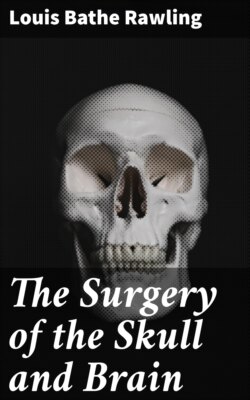Читать книгу The Surgery of the Skull and Brain - Louis Bathe Rawling - Страница 72
На сайте Литреса книга снята с продажи.
Treatment.
ОглавлениеThe age of the patient must not be allowed to weigh in the balance against operative treatment, for, if due precautions be taken, the new-born child stands operation well. Cushing points out that ‘the possibilities of surgical relief are limited to the first week or two after the hæmorrhage has occurred, for old cortical scars can neither be helped by medicine nor by the scalpel’.
The clot can be exposed by craniectomy or by craniotomy. The latter operation results in a more complete exposure, but the shock is undoubtedly more severe. Exposure by craniotomy is advocated by Cushing, and carried out in the following manner: ‘An omega-shaped incision just within the outer margin of the parietal bone is carried down to the bone through the scalp and pericranium, and the latter is scraped away so as to expose the thin serrated edge of the parietal bone. Under this a blunt dissector is passed, so that the edge of the bone is tilted up, and then, with a proper cutting instrument (strong blunt-pointed scissors suffice), the bone is incised in a line conforming with the skin incision 1 centimetre or more within the parietal margin. The parietal bone is then broken across at its base. The dura is opened by a curved incision some distance within the bony margin, and the superficial clot broken away or lifted off in fragments, or irrigated away with a gentle stream of warm saline solution. The dura should be accurately sutured, the bone replaced, and the skin closed with suture.’
He reports on 9 cases so treated, with 4 recoveries, apparently complete and permanent. The fatal cases were all associated with extensive extravasation over the entire hemisphere. In 3 cases bilateral exposure was necessitated.
Taking, however, the question into more general consideration, it would appear that equally satisfactory results can be obtained, with a lesser degree of operative danger, by carrying out craniectomy in the manner described in the treatment of ‘traumatic subdural hæmorrhage’ (see p. 156).
